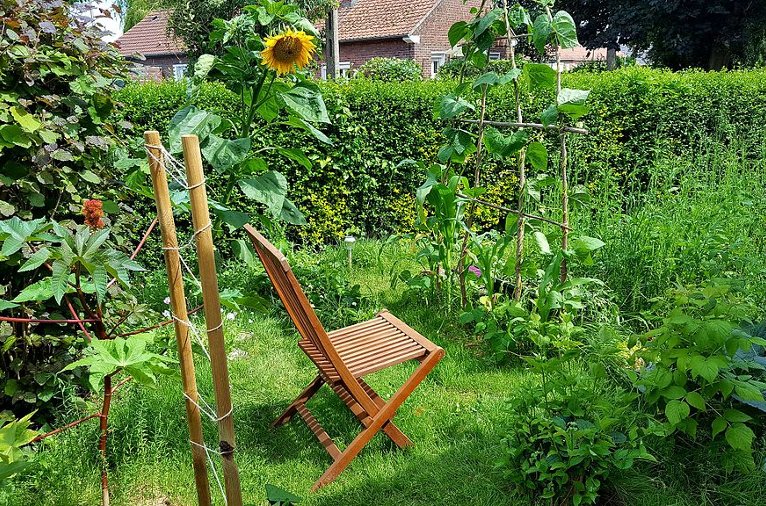[ Part 2 of Visit to a future sustainable neighborhood ]
As I took my first breath in this future neighborhood, the air had a fragrant quality that I didn’t recognize. I could hear a person shout something, maybe a block away. It’s much quieter than the world I left. There’s certainly a smell of home cooking in the air. And there’s a lot more plants of all sizes and description wherever I look. That’s it! The air carries a mixture of fruit scents.
When I can see through the vegetation, the built environment has changed. Seems everyone has some kind of glass or see-thru plastic structure connected to the southerly facing side of their houses. (Because I’m in the northern hemisphere. If I’d been in the southern, those would be on the north side of the house.) That encourages a longer food growing season in spring and fall, and in many places, greens grow all through the winter.
A lot of those walls are painted dark blue, reds and browns, probably to absorb more of the winter sun’s heat. On that side of the houses, there’s also a darker color of window blinds, for those who have them, probably for the same reason.
Wherever there’s a flat roof, there’s either a glow above it, suggesting a reflecting surface, or there’s a low railing with what looks like, edible plants growing on the roof.
The gardens might look like plant chaos to some, but actually, I can see, it’s very deliberate managed abundance.
There are strange configurations of gutters and downspouts connected around the buildings, suggesting people are making efforts at rainwater harvesting; maybe for their plantings, or household use and supplemental drinking water. Sky-water I call it, it’s everywhere when there’s no drought. Yes, I can see large tanks beautifully decorated and cleverly integrated into the landscaping. There must be a need to capture water when it’s abundant.
Here and there, behind dense hedgerows, I can hear the cluck of chickens. Oh, and what’s that? Gave me a shock, it’s a large goat jumping up to look at me over the top of a fence as I pass by. Hey, goaty!
Almost all roofs have some configuration of solar voltaic or hot water panels and what looks like miniature wind turbines, integrated into the roof design. Some roofs seem to have another roof suspended above the original one, kind of like the safari roof on the old 20th century Landrover vehicles; maybe that’s a cooling strategy?
On the next block I can see workers retrofitting a house with a partial basement or cellar. Below the frost line in any country the earth is a constant 45-50 degrees Fahrenheit, 7 – 10 degrees Celsius. In the U.S., before electrification, this advantage was used to store vegetables for months in winter (root cellars), to prevent them from freezing. But now, in an ever-warming world, it’s a great passive way to keep a cool room in summer. Houses with basements have become a premium.
Oh, here’s a sign: “Free extra compost, please take”. That’s nice, I sense many people have integrated an organic edible gardening lifestyle into their daily rounds. And there’s a lot more people cycling, walking in the streets and pottering around in their gardens, and it’s a week day. That suggests work-week hours have been reduced, probably due to robotics and AI in the workplace, and a reduction in consumerism from resources becoming strained to their limits.
Another sign: “Jane and Charly’s wood shop 9 to 5 week days”. And a temporary sign: “Surplus hemp cloth available at # 17”. Sounds like working with fabric is popular again. What’s this? It reads: “Site of our new Hentrepreneur center”, (Household entrepreneur). I notice it says “our” center, not “the” center, I sense a community spirit in this neighborhood.
There’s graffiti on this building site, it says, “Solve basic needs for everyone first.” And another: “Aquaponics Association supports more fish and chips.” And over there: “Forget MTV, embrace MITP: Music In The Park, every Saturday afternoon and evening.”
Here and there are obelisk shaped structures about 2 meters or yards high, they are electric backup storage batteries for the grid, to facilitate solar and wind generated electricity. Their walls have become unofficial bulletin boards, posted with information about local services and objects for free recycling.
In some neighborhoods the first small electric generating stations are being built, powered by the heat from thousand-foot-deep geothermal wells. Decentralization of the grid is now a priority for more security. (This had only been made possible recently because the majority of people finally understood how the fossil fuel industry had for years been one of the greatest impediments to alternative inventive progress.)
Most neighbors belong to the local Timeshare association. And every street has public benches where one can rest or have a chat with a neighbor, with bicycle racks designed in.
I come across a small group of people filling in potholes in the road, one person from the town public works department, with a few neighborhood volunteers. This has become a standard arrangement in many municipalities in recent years. Looks like a local resident is bringing out some refreshment for them, I think I’ll head over and see if I can get in on it! And, I’m sure, there’s still more to discover that isn’t visible.
[ Part 2 of Visit to a future sustainable neighborhood ]





